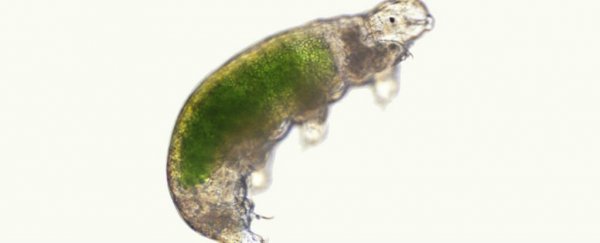Last month, scientists from the University of North Carolina at Chapel Hill (UNC) sequenced the genome of the mysterious tardigrade for the first time and found that, incredibly, around 6,600 of its genes had been transferred from other species – which is way more foreign DNA than has been previously been found in other animals' genomes.
Naturally, we got pretty excited about the research. After all, the tardigrade, or water bear, is already a super weird animal, and the fact that a large chunk of its DNA appeared to have been horizontally transferred from other organisms is fascinating. But the claim is already beginning to fall apart, with a separate team of scientists from the University of Edinburgh in the UK having sequenced the genome of the same species of tardigrades purchased from the same supplier, and only finding at most 500 genes to have come from other species.
The Edinburgh team has concluded that the original researchers inadvertently sequenced DNA from bacteria living alongside the tardigrades, despite attempts to eliminate this contamination, as Ed Yong reports for The Atlantic. And it's an easy mistake to make seeing as until recently, scientists had to break DNA samples into small pieces in order to sequence it, and then reassemble those sequences later on to recreate the whole genome.
That's the technique both teams used, but when the Edinburgh researchers sequenced the DNA, they came back with some strange results. Normally each gene in an animal's genome will come up roughly the same amount of times throughout a sample, because cells all have the same DNA. But the University of Edinburgh scientists found that some of the Tardigrade genes were incredibly rare, while some were 10 times more common.
"There is no way, biologically, these can be part of the same genome," lead researcher Mark Blaxter, from the University of Edinburgh, told Yong, concluding that the odd genes must have come from bacterial contamination. So the team worked to clean up any bacteria that might have been stowed away with the samples.
After doing this they found only 500 genes that the Tardigrade appeared to have transferred from other species, but they only have strong evidence that 36 of these were a result of horizontal transfer from bacteria – which is an estimate more in line with the amount of foreign DNA found in most other animals. They've published their paper on the pre-print server Biorxiv.
"Worryingly, they found that the UNC data included many reads that they hadn't seen at all – even though both groups sequenced the same animals," writes Yong for The Atlantic. "Based on this, the Edinburgh team concluded that around 30 percent of the UNC genome probably came from contaminating microbes."
Of course, the UNC researchers considered the possibility of contamination before publishing their results, and worked hard to eliminate any stray bacteria from their samples.
To do this, they analysed in detail 107 of the foreign genes, and showed that they were connected on the same strand of DNA to the tardigrade's own genes. They also used another analysis system, which doesn't first break the DNA up before sequencing it, and found that the bacterial genes were physically linked to the animal ones. The Edinburgh scientists haven't released the results of their same analysis as yet.
"We thought seriously about the possibility of contamination – it was of course the most likely initial explanation for the large amount of foreign DNA found in our assembly – and much of the analysis in our paper was designed specifically to address this issue," said Thomas Boothby, one of the North Carolina researchers, in a comment on the new paper.
The next step will be to sequence the genomes of other tardigrade species to see how many of their genes appear to come from other organisms – if there's evidence of extreme horizontal transfer occurring, then it would be pretty strong evidence that it's real.
But for now we have to wait for more research to fully understand what's going on. Which may sound frustrating, but it's one of the things we love about science – it's constantly working on improving itself.
Update 29 March 2016: The team led by Mark Blaxter has published a new paper published in the Proceedings of the National Academy of Sciences, which shows there's no evidence that the tardigrade's proposed 'foreign DNA' came from anything other than bacterial contamination.
"What would in decades past have taken many months to sort out became the focus of experts around the world and has been swiftly resolved," said Blaxter. "We hope this paper will finally correct the scientific record. Tardigrades are amazing organisms, but these suggestions about their DNA were a step too far, even for their eight legs."
